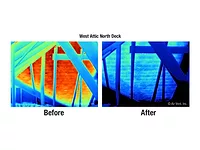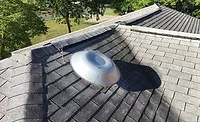Vent or Seal the Attic?
Ease of Installation Is Only One of Several Variables That Support Venting
In this article -
Keeping Insulaion Simple
Having Troubleshooting Options
Year-Round Performance in All Climates
Managing Costs and ROI
The International Residential Building Code (IRC) is the predominant single-family residential building code in the United States. Vented attics are the “default” construction practice recognized by the IRC. Changes to recent editions of the IRC have introduced unvented (sealed) attics as an alternative. Deciding which approach to take should include consideration of issues such as ease of installation, ability to troubleshoot after the fact, performance, upfront cost and return on investment. The Roof Assembly Ventilation Coalition — which consists of most of the major attic ventilation manufacturers — is committed to helping roofing professionals better understand the benefits of proper attic ventilation.
Keeping Installation Simple
For best performance, vented attics need a balanced amount of intake vents and exhaust vents in a quantity determined by the attic’s square footage. Cut some holes. Position and fasten the vents. Move on. Obviously it’s a bit more complex than that — but not much. Attic ventilation is usually pretty simple. Not every attic design lends itself to an easy ventilation solution, but most knowledgeable roofing professionals can design an attic ventilation solution for even the most challenging projects.
To properly seal an attic (make it an unvented assembly), however, the 2012 IRC details multiple levels of considerations, not the least of which is installing the necessary amount of insulation to bring the attic “within the building thermal envelope” (IRC R806.5). Adding an attic to the home’s overall conditioned space volume is not simple or always practical.
Having Troubleshooting Options
In a 2009 American Society for Testing and Materials paper titled “Compact Asphalt Shingle Roof Systems: Should They Be Vented,” authors Peter E. Nelson and Jason S. Der Ananian noted, “The longevity of the roof assembly also relies on the occupant’s ability to identify whether leakage or wetting is occurring and to provide leak repair. If the leakage is concealed or unnoticeable, the damage will go undetected.” While no one wants something to go wrong inside the attic, the fact is it’s an application advantage to be able to visually inspect a vented attic for signs of trouble. If spray foam insulation is installed along the underside of the roof deck in an unvented attic, how can a troubleshooting inspection take place? The potential consequences of an undetected leak or moisture problem can be significant both in terms of damage and cost.
Year-Round Performance in All Climates
“Shingles that are installed on unvented roof assembles operate at slightly higher temperatures, roughly 2-3 degrees Fahrenheit warmer than shingles on vented assembles. This can reduce their service life by roughly 10 percent,” said Joseph Lstiburek of Building Science Corporation (in the August/September 2011 Fine Homebuildingarticle, “A Crash Course in Roof Venting”). If roofing professionals are not worried about a 10 percent service life reduction, the homeowner might be. Additionally, it’s a wise practice for homeowners and roofing professionals alike to familiarize themselves with the particulars of shingle warranties offered by the manufacturer.
Heat buildup should not be the only concern here. In a paper titled “Internal Microclimate Resulting from Ventilated Attics in Hot Humid Regions,” University of Florida researchers Dr. Wendell Porter and Barrett Mooney discuss potential moisture buildup issues. They state, “It is possible that sealing the attic spaces entirely and insulating the structure would reduce the thermal transfer from an attic, but this would provide no outlet for moisture transported through porous roofing materials or past the ceiling plane.” Porter and Mooney go on to explain that vented attics allow for the safe removal of the moisture.
Taking into account the potential heat and moisture buildup problems associated with unvented attic assemblies, it makes sense that plywood manufacturers are concerned. In a 2012 technical bulletin titled “How to Minimize Buckling of Asphalt Shingles,” the APA (Engineered Wood Association) contained the following statement about sealed, unvented attics: “Because of limited field experience, the APA is unable to recommend these systems at this time.”
Managing Cost and ROI
Roofing contractors tell us that the cost (material, time and labor) of the exhaust and intake vents needed to properly balance an attic is a small percentage of the overall expense to roof the house. Can the same be said for the upfront cost to seal an attic? Homeowners should ask themselves: “How many years will it take to receive a return on investment to vent an attic versus seal an attic?”
Looking for a reprint of this article?
From high-res PDFs to custom plaques, order your copy today!




.webp?height=200&t=1628274832&width=200)

